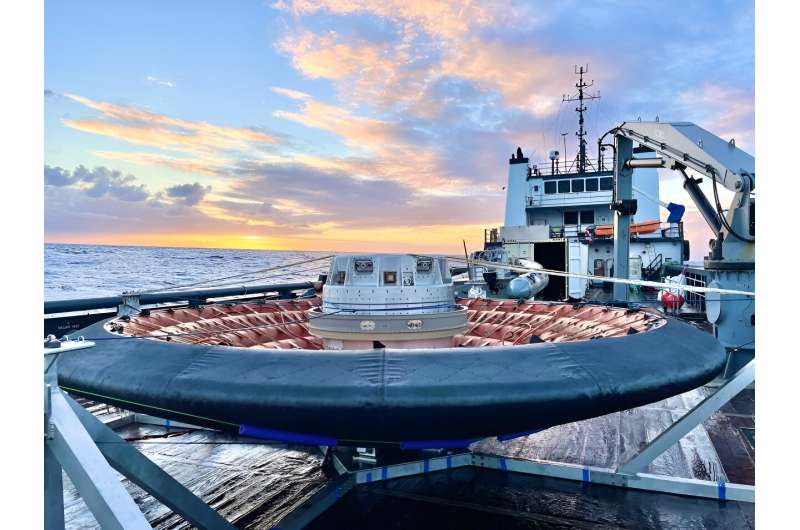This article has been reviewed according to Science X's editorial process and policies. Editors have highlighted the following attributes while ensuring the content's credibility:
fact-checked
trusted source
proofread
NASA's 'flawless' heat shield demo passes the test

A little more than a year ago, a NASA flight test article came screaming back from space at more than 18,000 mph, reaching temperatures of nearly 2,700°F before gently splashing down in the Pacific Ocean. At that moment, it became the largest blunt body—a type of reentry vehicle that creates a heat-deflecting shockwave—ever to reenter Earth's atmosphere.
The Low-Earth Orbit Flight Test of an Inflatable Decelerator (LOFTID) launched on Nov. 10, 2022, aboard a United Launch Alliance (ULA) Atlas V rocket and successfully demonstrated an inflatable heat shield. Also known as a Hypersonic Inflatable Aerodynamic Decelerator (HIAD) aeroshell, this technology could allow larger spacecraft to safely descend through the atmospheres of celestial bodies like Mars, Venus, and even Saturn's moon, Titan.
"Large-diameter aeroshells allow us to deliver critical support hardware, and potentially even crew, to the surface of planets with atmospheres. This capability is crucial for the nation's ambition of expanding human and robotic exploration across our solar system," said Trudy Kortes, director of the Technology Demonstrations Missions (TDM) program within the agency's Space Technology Mission Directorate (STMD) at NASA Headquarters in Washington.
NASA has been developing HIAD technologies for over a decade, including two smaller scale suborbital flight tests before LOFTID. In addition to this successful tech demo, NASA is investigating future applications, including partnering with commercial companies to develop technologies for small satellite reentry, aerocapture, and cislunar payloads.
"This was a keystone event for us, and the short answer is: It was highly successful," said LOFTID Project Manager Joe Del Corso. "Our assessment of LOFTID concluded with the promise of what this technology may do to empower the exploration of deep space."
Due to the success of the LOFTID tech demo, NASA announced under its Tipping Point program that it would partner with ULA to develop and deliver the "next size up," a larger 12-meter HIAD aeroshell for recovering the company's Vulcan engines from low Earth orbit for reuse.
A successful test in the books, a video recap
The LOFTID team recently held a post-flight analysis assessment of the flight test at NASA's Langley Research Center in Hampton, Virginia. Their verdict?
Upon recovery, the team discovered LOFTID appeared pristine, with minimal damage, meaning its performance was, as Del Corso puts it, "Just flawless."
Here are some interesting visual highlights from LOFTID's flight test.
To get to atmospheric reentry, LOFTID had to go through an intricate sequence of events. Del Corso compared it to a Rube Goldberg device, a complex machine designed to carry out simple tasks through a series of chain reactions.
Video captured the moment LOFTID deployed the HIAD (on the left), compared to a preflight animation developed by NASA Langley's Advanced Concepts Lab (on the right). Inflation happens at the bottom of the video as LOFTID flies over the African continent.
As it flew over the Mediterranean Sea, LOFTID separated from the ULA Centaur upper stage. On the left, LOFTID is seen from Centaur's forward-facing camera. The composite image on the right is from cameras around LOFTID's center body, looking forward and outboard at the orange inflatable HIAD structure. In the center, looking back at Centaur, LOFTID is seen from an aft-facing camera.
As LOFTID reentered Earth's atmosphere and reached nearly 2,700°F, the extreme heat caused gases around it to ionize and form plasma. On the right, the images from the center body cameras became extremely bright in the visible spectrum, while the Earth is visible on infrared cameras as the vehicle rotated.
The camera captured footage of the plasma quickly changing colors from orange to purple. Why the color change? "We're still investigating exactly what causes that," said John DiNonno, LOFTID chief engineer. The animation on the left shows an artist's concept of what the front side may have looked like.
This video, captured by NASA Langley's Scientifically Calibrated In-Flight Imagery team, shows LOFTID during peak deceleration as the plasma recedes. On the left, LOFTID streaks through the night sky over the Pacific Ocean. On the right, the purple coloration flares up on the back side of LOFTID.
In the second part of the video, the left shifts to one of the cameras looking at the back of the aeroshell, with the receding plasma streaking at its edge.
After slowing down from more than 18,000 mph to less than 80 mph, LOFTID deployed its parachutes.
From an infrared camera aboard the recovery ship, this video shows the parachute deployment and splashdown just over the horizon. The preflight animation is provided on the right for comparison.
LOFTID splashed down in the Pacific Ocean several hundred miles off the east coast of Hawaii and only about eight miles from the recovery ship's bow—almost exactly as modeled. A crew got on a small boat and retrieved and hoisted LOFTID onto the recovery ship.
"The LOFTID mission was important because it proved the cutting-edge HIAD design functioned successfully at an appropriate scale and in a relevant environment," said Tawnya Laughinghouse, manager of the TDM program office at NASA's Marshall Space Flight Center in Huntsville, Alabama.
Provided by NASA




















